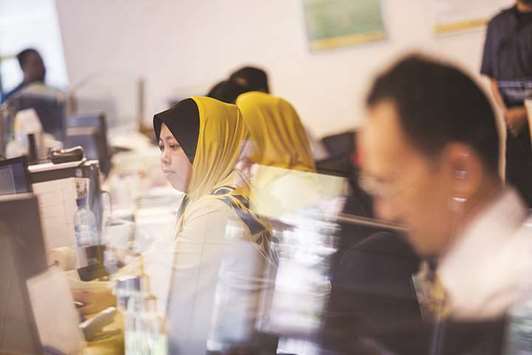The market for sukuk issuances is expected to become increasingly buoyant as Islamic bonds have successfully transformed themselves from a niche product – as what they were seen when they were introduced in the 1990 – to a widely accepted global asset class for a broad range of institutional and retail investors. Mainly confined to Muslim markets in the first two decades, things took off from the global stage in 2010 from when on sukuk issuance volumes grew by an average of 18% annually until they reached their peak in 2012. When oil prices collapsed in that year, sukuk issuances underwent a subdued phase, but recovered in 2016 to reach $85bn in issuance volume globally.
A report by rating agency Moody’s estimates total sukuk issuance will have reached around $95bn by the end of 2017, boosted by more than $50bn of sukuk issuance by sovereigns. According to the report, this is underpinned by a range of factors: Besides rising sovereign issuance also by product innovation, increasing demand from retail banks and a narrowing of spreads as compared to conventional bonds.
Another major growth driver for the market is the rising US investor participation as a result of more sukuk being issued in a US-investor friendly format, as well as huge financing opportunities arising from China’s Belt and Road initiative. Sukuk have also been discovered as being quite suitable for green and socially responsible investment, while more countries began issuing local currency sukuk for infrastructure and project funding.
All this helped in making sukuk an integral component of global capital markets, which, in turn, supports the Islamic finance market as a whole as conventional investors become confident in it and use the opportunity for asset diversification. In issuing countries, it also drives the continued evolution of Shariah-compliant structures and regulatory frameworks.
“We expect that sovereign sukuk issuance volumes will continue to grow in 2018 as governments look to diversify their financing mix and satisfy the liquidity needs of Islamic retail banks,” says Moody’s vice-president and senior credit officer Christian de Guzman, adding that “sovereigns have underpinned a recovery in the global sukuk market this year, with their issuance increasing by 50% in the first eight months of 2017.”
A driving factor for sovereign issuance are high borrowing needs from GCC countries, which Moody’s expects to reach around $148bn in 2018. A large chunk of the money demand comes from Saudi Arabia which is forecast to raise the lion’s share of sukuk during 2018 – as it did in 2017 at a total of $17bn, or 40% of global long-term sovereign sukuk issued in the first eight months of the year. Other countries with large fiscal deficits, such as Oman and Bahrain, will also contribute to the market’s expansion, Moody’s expects.
However, Malaysia is expected to hold on to its lead as the largest sukuk issuer globally and retain its over-40% market share next year – when general elections are due which will bring with it increased government spending.
Apart from that, an important growth driver is also the entrance of several new market players.
In the Middle East and North Africa, Jordan made its sukuk debut in May 2016, issuing $105.9mn in order to finance acquisitions by its national power company, and plans for more. Tunisia together with Bourse de Tunis and Nasdaq Dubai have set up a task force to pave the way for the country’s first-ever issuance of a sukuk with an envisaged volume of $500mn, while Morocco has also announced to issue a sukuk after the country introduced a legal framework for what it calls “participatory finance.”
Algeria plans to issue sukuk in 2018 to soften budgetary weakness caused by a drop in energy revenues. Iran is also under observation whether the country manages to create an operative environment to participate in the international debt markets, but so far there are still questions marks on that issue.
New sukuk issued in sub-Saharan Africa are also boosting the global Islamic debt market after it gained traction in the region, with total sukuk outstanding having grown to $1.5bn in 2016 from just $273mn in 2015. Main players are Ivory Coast, Togo, Senegal and Nigeria, which issued a $328mn sovereign sukuk in September 2017, as well as Ghana with a January 2017-issuance of a maiden sukuk at a volume of $150mn.
In terms of new products, Malaysia was the first country to see issuances of “green sukuk” this year used to finance environmental and sustainable projects, including solar power plants. The country also made a foray into “impact investing” through sukuk by issuing a tranche whose proceeds were used for a trust school programme.
Indonesia, which has emerged as a strong player in the sukuk market in the last years and is even expected to catch up on Malaysia over time, is working towards launching a green bond framework to issue green sukuk, as well as introduce sukuk based on waqf, or charitable endowments, and on remittances from Indonesian migrant workers. All this is part of Indonesia’s sukuk masterplan, unveiled in September last year, which aims at raising sovereign sukuk at the amount of 50% of total debt issuance over the following ten years, mainly to fund infrastructure, education and agriculture projects.

Employees work at a service counter inside a combined Malayan Banking (Maybank) and Maybank Islamic bank branch in Kuala Lumpur (file). Malaysia is expected to hold on to its lead as the largest sukuk issuer globally and retain its over-40% market share next year.


